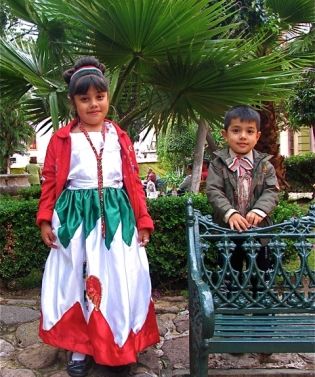
Publisher:
Bonnie King
CONTACT:
Newsroom@Salem-news.com
Advertising:
Adsales@Salem-news.com

~Truth~
~Justice~
~Peace~
TJP
Sep-20-2010 14:04

 TweetFollow @OregonNews
TweetFollow @OregonNews
Mexico's 2010 Bicentennial Independence Celebration
Ralph E. Stone Salem-News.comYou don't have to be Mexican to enjoy the Bicentennial/Centennial celebrations or appreciate the importance of the events to Mexicans all over the world.
 Brother and Sister in Independence Day celebration costumes, Guanajuato, Mexico, Sept. 16. 2008. Photo by Judi Iranyi |
(SAN FRANCISCO) - During the entire calendar year 2010, Mexico will celebrate the Bicentennial of Mexican Independence, which dates back to September 16, 1810, and eventually resulted in Mexico's independence from Spain in 1821. Thus, this year there will be a concurrent Centennial celebration of Mexico's actual independence.
In 2008, my wife and I enjoyed the independence celebrations in the cities of Guanajuato, San Miguel de Allende, and Querétaro. Each of these cities had an individual who sparked the independence struggle: Father Miguel Hidalgo y Costilla, Ignacio Allende, and Doña Josefa Ortiz.
Father Miguel Hidalgo was a parish priest of Dolores, a small village in the state of Guanajuato. His famous "Grito de Dolores or Independencia," or call for independence to the Amerindians and mestizos to retaliate against the hated native Spaniards, who had exploited and oppressed Mexicans for ten generations. (Did you know there is a statue of Don Miguel Hidalgo in San Francisco's Dolores Park?)
Ignacio Allende was a criollo, a social class in the caste system established by Spain in the 16th century for its overseas colonies, especially in Latin America. Criollos comprised the locally born people of pure Spanish ancestry. The criollo class ranked below the peninsulars, the colonists born in Spain, but above Amerindians and those of mixed ancestry. The peninsulars became known as "gachupines," an insulting label for Spaniards in pre-independence Mexico. The top ecclesiastical, military, and administrative positions were reserved for crown-appointed peninsulares. This caused much resentment among the criollos and, as a result, many criollos, including Allende, became involved in the independence movement.
The independence movement was scheduled to begin in October 1810. However, in early September, the gachupines learned about the movement and targeted Father Hidalgo for arrest.
Enter Doña Josefa Ortiz, the wife of Don Miguel Dominguez, the “El Corregidor” or mayor of the city of Querétaro. (Thus, she is also known as “La Corregidora.”) She was an early financial supporter of the independence movement much to the chagrin of her husband. She learned that the independence movement had been discovered and that Hidalgo was to be arrested. She sent word to Juan de Aldama, another conspirator, who then rushed to Dolores and found Allende in Hidalgo's house. They made the decision to go ahead with the movement. Hidalgo made his famous “El Grito de Independencia" on the morning of September 16, 1810. (While on a day trip to Querétaro, we visited the Monumento a la Corregidora, a statue of Doña Josefa Ortiz holding the flame of freedom.)
The citizens of the city of Guanajuato joined the independence fight and defeated the Spanish, seizing the city of Guanajuato. Later when the Spanish retook the city, they retaliated by conducting the infamous "lottery of death," in which names of Guanajuato citizens were drawn and those selected were tortured and hanged. The heads of four leaders of the independence movement, including Hidalgo and Allende were hung from Alhóndiga de Granaditas, the site of the first rebel victory in the fight for independence.
In the early evening of September 15, 2008, we joined the crowd at the Plaza Alhóndiga in Guanajuato in front of the Alhóndiga de Granaditas where, as mentioned earlier, Hildago and Allende's heads were hung. We were treated to music and singing. Even a light rain didn't deter the crowd's enthusiasm. At 11:00 p.m., a government official gave the Grito or cry of Independence: "Mexicanos, viva México." And then the crowd joined in with their shouts. After the Grito, fireworks lit up the sky. From our hotel room we could hear sounds of partying and fireworks into the wee hours of September 16th. This moment was reenacted in every plaza or zócalo of Mexico, and commemorated by Mexicans all over the world.
The next day, on September 16, there was a parade through the city made up of school groups in costume, some playing instruments, teachers, and city officials and dignitaries. On every street corner there were vendors selling flags, balloons, all with the green, white and red of the National Colors. Flags waved from practically every house and building. Numerous stands were set up several days before and offered the traditional finger foods, Mexican candies, and punch. Many people walked around dressed in typical Mexican dress or indigenous costumes. After the parade, Mariachi bands played in the Jardin de la Unión.
Later, we visited San Miguel de Allende and the Independence Day celebrations were continuing there with music, art, and other cultural events. The Independence Day celebrations seemed to stretch out into several weeks.
You don't have to be Mexican to enjoy the Bicentennial/Centennial celebrations or appreciate the importance of the events to Mexicans all over the world.
 Salem-News.com writer Ralph E. Stone was born in Massachusetts. He is a graduate of both Middlebury College and Suffolk Law School. We are very fortunate to have this writer's talents in this troubling world; Ralph has an eye for detail that others miss. As is the case with many Salem-News.com writers, Ralph is an American Veteran who served in war. Ralph served his nation after college as a U.S. Army officer during the Vietnam war. After Vietnam, he went on to have a career with the Federal Trade Commission as an Attorney specializing in Consumer and Antitrust Law. Over the years, Ralph has traveled extensively with his wife Judi, taking in data from all over the world, which today adds to his collective knowledge about extremely important subjects like the economy and taxation. You can send Ralph an email at this address stonere@earthlink.net
Salem-News.com writer Ralph E. Stone was born in Massachusetts. He is a graduate of both Middlebury College and Suffolk Law School. We are very fortunate to have this writer's talents in this troubling world; Ralph has an eye for detail that others miss. As is the case with many Salem-News.com writers, Ralph is an American Veteran who served in war. Ralph served his nation after college as a U.S. Army officer during the Vietnam war. After Vietnam, he went on to have a career with the Federal Trade Commission as an Attorney specializing in Consumer and Antitrust Law. Over the years, Ralph has traveled extensively with his wife Judi, taking in data from all over the world, which today adds to his collective knowledge about extremely important subjects like the economy and taxation. You can send Ralph an email at this address stonere@earthlink.net
Articles for September 19, 2010 | Articles for September 20, 2010 | Articles for September 21, 2010
Quick Links
DINING
Willamette UniversityGoudy Commons Cafe
Dine on the Queen
Willamette Queen Sternwheeler
MUST SEE SALEM
Oregon Capitol ToursCapitol History Gateway
Willamette River Ride
Willamette Queen Sternwheeler
Historic Home Tours:
Deepwood Museum
The Bush House
Gaiety Hollow Garden
AUCTIONS - APPRAISALS
Auction Masters & AppraisalsCONSTRUCTION SERVICES
Roofing and ContractingSheridan, Ore.
ONLINE SHOPPING
Special Occasion DressesAdvertise with Salem-News
Contact:AdSales@Salem-News.com

googlec507860f6901db00.html



Terms of Service | Privacy Policy
All comments and messages are approved by people and self promotional links or unacceptable comments are denied.
[Return to Top]
©2025 Salem-News.com. All opinions expressed in this article are those of the author and do not necessarily reflect those of Salem-News.com.